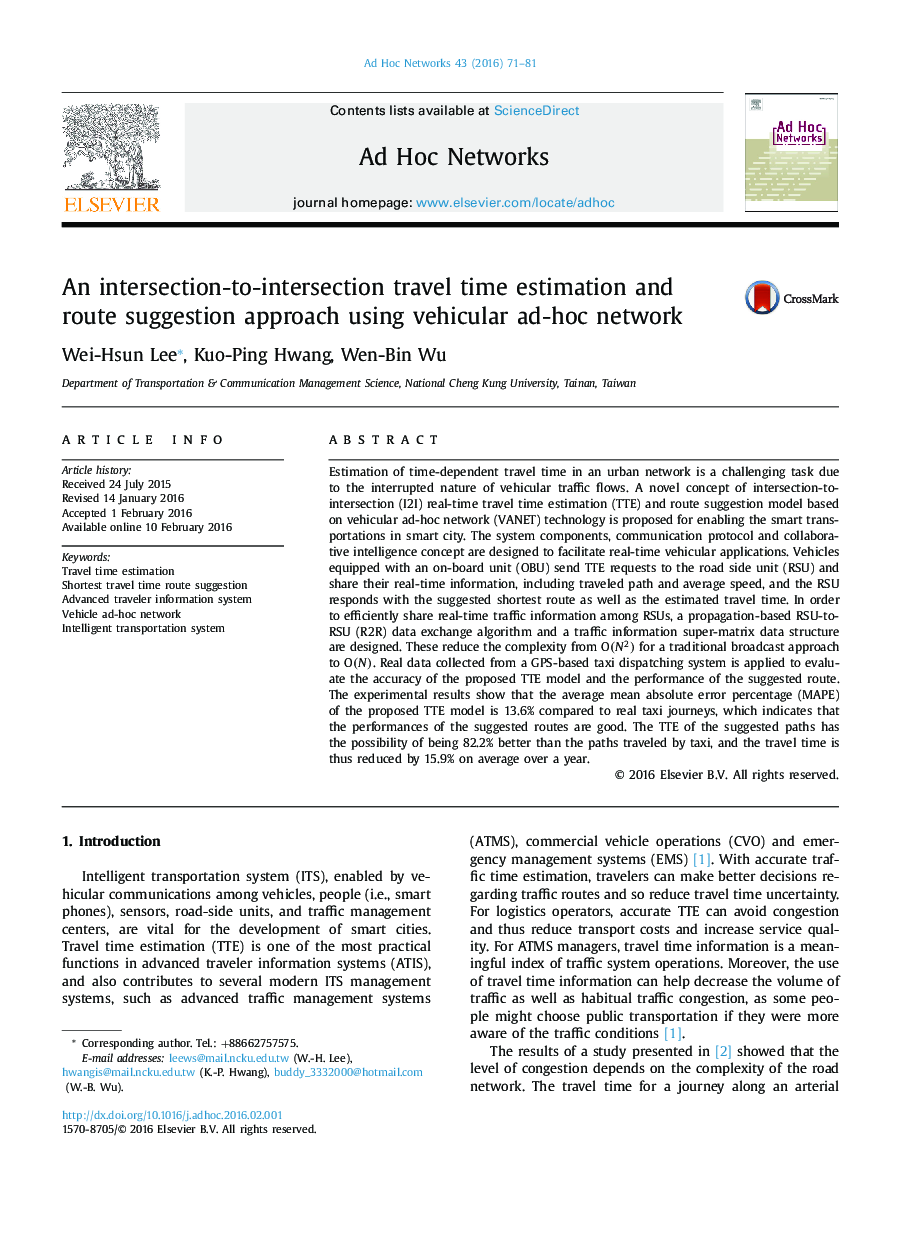| کد مقاله | کد نشریه | سال انتشار | مقاله انگلیسی | نسخه تمام متن |
|---|---|---|---|---|
| 444240 | 692950 | 2016 | 11 صفحه PDF | دانلود رایگان |
کلید واژه ها
1.مقدمه
2.کارهای مشابه
نمودار 1: مفهوم TTE I2I و سیستم پیشنهاد مسیر
3. I2I برآورد زمان سفر و سیستم پیشنهاد مسیر
3-1- همجوشی خطی پویا از اطلاعات زمان واقعی و تاریخی مدل TTE
3-2. مفهوم سیستم و پروتکل
جدول1: نماد ها در جدول ابر ماتریس
3.3. مکانیزم مبادله اطلاعات R2R
شکل 2: یک نمونه از انتشار دو مرحله ای در شبکه 5 در 5 است.
شکل 3: شبکه ترافیکی تجربی در شهر تینان
4.ارزیابی ها
4.1. داده های تجربی و توضیحات محیط زیست
جدول 2: طبقه بندی ابعاد زمانی
جدول 3: نتایج تجربی برای مورد 1: مبدا (شماره 8) ← مقصد (شماره 15).
شکل 4: ارزیابی دقت TTE برای مورد 1
نمودار 5: عملکرد مسیر های پیشنهاد شده در مورد 1
4.2. مورد 1: تقاطع های شماره 15-8
جدول 4: نتایج ارزیابی ها برای مورد 1: مبدا شماره 8 ← مقصد شماره 37
4.3. مورد 2: تقاطع های شماره 8 تا 37
شکل 6: ارزیابی دقیق TTE مورد 2
شکل 7: عملکرد مسیر پیشنهادی در مورد دوم
5. نتیجه گیری
ضمیمه: لیست خلاصه شده ها
Estimation of time-dependent travel time in an urban network is a challenging task due to the interrupted nature of vehicular traffic flows. A novel concept of intersection-to-intersection (I2I) real-time travel time estimation (TTE) and route suggestion model based on vehicular ad-hoc network (VANET) technology is proposed for enabling the smart transportations in smart city. The system components, communication protocol and collaborative intelligence concept are designed to facilitate real-time vehicular applications. Vehicles equipped with an on-board unit (OBU) send TTE requests to the road side unit (RSU) and share their real-time information, including traveled path and average speed, and the RSU responds with the suggested shortest route as well as the estimated travel time. In order to efficiently share real-time traffic information among RSUs, a propagation-based RSU-to-RSU (R2R) data exchange algorithm and a traffic information super-matrix data structure are designed. These reduce the complexity from O(N2) for a traditional broadcast approach to O(N). Real data collected from a GPS-based taxi dispatching system is applied to evaluate the accuracy of the proposed TTE model and the performance of the suggested route. The experimental results show that the average mean absolute error percentage (MAPE) of the proposed TTE model is 13.6% compared to real taxi journeys, which indicates that the performances of the suggested routes are good. The TTE of the suggested paths has the possibility of being 82.2% better than the paths traveled by taxi, and the travel time is thus reduced by 15.9% on average over a year.
Journal: Ad Hoc Networks - Volume 43, June 2016, Pages 71–81
